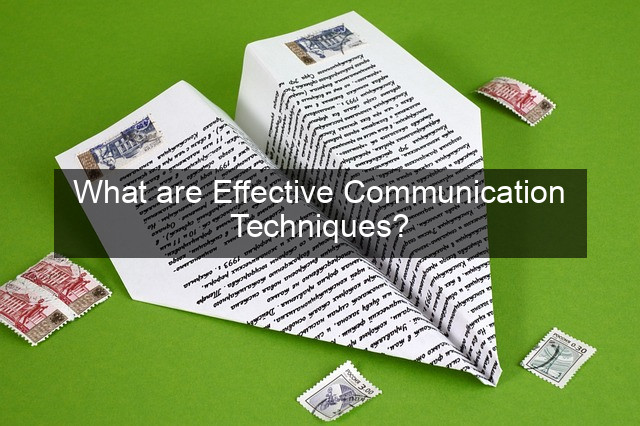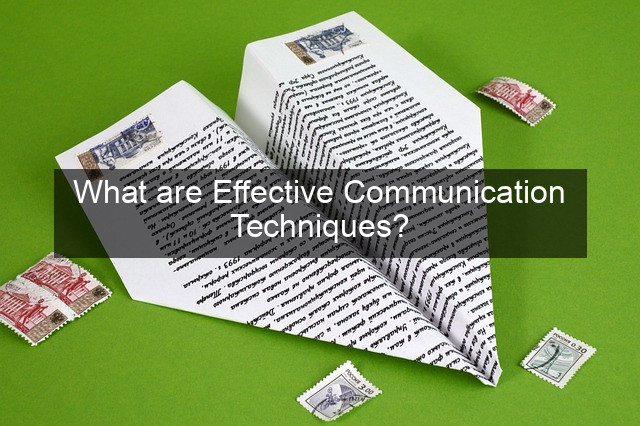What are Effective Communication Techniques?

- What are Effective Communication Techniques?
- What are Effective Communication Techniques?
- Verbal Communication: The Power of Words
- Clarity and Conciseness
- Tone and Inflection
- Active Listening
- Nonverbal Communication: Beyond Words
- Body Language
- Gestures and Expressions
- Personal Space
- Written Communication: Crafting Clear Messages
- Structure and Organization
- Grammar and Style
- Visual Aids
- Conclusion
- Frequently Asked Questions

What are Effective Communication Techniques?
In today’s interconnected world, effective communication is more crucial than ever. Whether you’re navigating the complexities of the workplace, nurturing personal relationships, or simply trying to get your point across, honing your communication skills can significantly impact your success and overall well-being. Effective communication isn’t just about speaking clearly; it’s about understanding your audience, crafting your message thoughtfully, and choosing the right medium for delivery. It involves active listening, non-verbal cues, and the ability to adapt your style to different situations. This article will delve into the key techniques that can transform you into a more confident and impactful communicator, enabling you to build stronger connections, foster collaboration, and achieve your goals.
Verbal Communication: The Power of Words
Clarity and Conciseness
The cornerstone of effective verbal communication lies in clarity and conciseness. Avoid jargon and overly complex language that might confuse your audience. Instead, opt for precise wording and straightforward sentence structure. Get straight to the point and deliver your message succinctly, respecting your audience’s time and attention.
Think of your communication like a well-crafted story. It should have a beginning, a middle, and an end. Each point you make should contribute to the overall narrative, and there should be a clear flow of ideas. This structure helps your audience follow along and understand your message more easily.
Practice is key to improving clarity and conciseness. Record yourself speaking or rehearse presentations in front of a mirror. Pay attention to how you articulate your thoughts and identify areas where you can be more direct and to the point.
Tone and Inflection
The way you say something can be just as important as what you say. Your tone of voice and inflection can convey emotions, emphasize key points, and build rapport with your audience. A warm and enthusiastic tone can make your message more engaging, while a monotone voice can make even the most interesting topic seem dull.
Consider the context of your communication and adjust your tone accordingly. A formal presentation requires a more professional tone, while a casual conversation with a friend allows for a more relaxed and informal approach.
Pay attention to the tone and inflection of others when they speak to you. This can provide valuable insights into their emotional state and help you respond appropriately.
Active Listening
Effective communication is a two-way street. Active listening is just as important as speaking clearly. It involves paying close attention to what the other person is saying, both verbally and nonverbally. Ask clarifying questions, summarize their points to ensure understanding, and offer feedback to show that you’re engaged in the conversation.
Avoid interrupting or formulating your response while the other person is still speaking. Give them your full attention and allow them to complete their thoughts before offering your perspective.
Practice empathy by trying to see things from the other person’s point of view. This can help you understand their motivations and concerns, leading to more productive and meaningful conversations.
Nonverbal Communication: Beyond Words
Body Language
Your body language speaks volumes, often conveying more than words alone. Maintain eye contact to show engagement, use open and inviting postures, and be mindful of your facial expressions. These nonverbal cues can reinforce your message and build trust with your audience.
Avoid closed-off postures like crossing your arms or looking down, as these can signal disinterest or defensiveness. Instead, maintain an open and approachable stance to encourage communication.
Practice mirroring the body language of the person you’re communicating with. This can create a sense of rapport and connection, making the interaction more comfortable and effective.
Gestures and Expressions
Gestures and facial expressions can add depth and emphasis to your verbal message. Use hand gestures to illustrate points, but avoid excessive or distracting movements. Your facial expressions should align with the tone of your message, conveying sincerity and authenticity.
Be mindful of cultural differences in nonverbal communication. Certain gestures or expressions may have different meanings in different cultures, so it’s important to be aware of these nuances.
Observe how others use gestures and expressions in different communication settings. This can help you refine your own nonverbal communication skills and adapt to different audiences.
Personal Space
Respecting personal space is crucial for creating a comfortable communication environment. Maintain an appropriate distance from the person you’re speaking with, and be mindful of cultural norms regarding personal space.
Avoid invading someone’s personal space by standing too close or touching them inappropriately. This can make the other person feel uncomfortable and hinder effective communication.
Observe how others maintain personal space in different social settings. This can help you develop a better understanding of appropriate distances and avoid causing discomfort.
Written Communication: Crafting Clear Messages
Structure and Organization
Well-structured written communication is essential for conveying information clearly and effectively. Use headings, subheadings, and bullet points to organize your thoughts and make your writing easier to scan. A logical flow of ideas ensures that your message is easy to follow and understand.
Consider your audience and purpose when structuring your writing. A formal report requires a different structure than a casual email.
Use outlines and mind maps to plan your writing before you begin. This can help you organize your thoughts and ensure a logical flow of ideas.
Grammar and Style
Proper grammar and style are essential for conveying professionalism and credibility. Proofread your writing carefully to eliminate errors in grammar, spelling, and punctuation. Choose a writing style that is appropriate for your audience and purpose.
Use a variety of sentence structures to keep your writing engaging. Avoid repetitive sentence patterns and vary the length of your sentences.

Consult style guides and grammar resources to improve your writing skills. There are many online resources available that can help you refine your grammar and style.
Visual Aids
Visual aids, such as charts, graphs, and images, can enhance written communication by making complex information easier to understand. Use visuals strategically to illustrate key points and add visual interest to your writing.
Choose visuals that are relevant to your message and avoid cluttering your writing with unnecessary graphics.
Ensure that your visuals are clear, concise, and easy to interpret. Use labels and captions to explain the information presented in your visuals.
| Communication Type | Key Elements |
|---|---|
| Verbal | Clarity, Tone, Active Listening |
| Nonverbal | Body Language, Gestures, Personal Space |
| Written | Structure, Grammar, Visual Aids |
- Practice active listening.
- Be mindful of your body language.
- Proofread your written communication.
Conclusion
Mastering effective communication techniques is a journey, not a destination. By continually practicing and refining these skills, you can significantly enhance your ability to connect with others, build strong relationships, and achieve your goals. Effective communication empowers you to express yourself clearly, navigate complex situations with confidence, and make a lasting impact on the world around you. Embrace the power of communication and unlock your full potential.
Frequently Asked Questions
What is the most important aspect of effective communication?
While all aspects are important, active listening is arguably the most crucial. Truly understanding the other person’s perspective is the foundation for meaningful and productive communication.
How can I improve my nonverbal communication skills?
Pay attention to your body language, practice making eye contact, and be mindful of your gestures and facial expressions. Observing others can also provide valuable insights.
What are some common communication barriers?
Common barriers include distractions, preconceived notions, cultural differences, and lack of clarity in messaging.
How can I tailor my communication style to different audiences?
Consider the context, the relationship you have with the audience, and their level of understanding of the topic. Adapt your language, tone, and delivery accordingly.
What is the role of empathy in effective communication?
Empathy allows you to understand and share the feelings of others, which is essential for building rapport and resolving conflicts constructively.
How can I become a more confident communicator?
Practice regularly, seek feedback from others, and focus on developing your active listening skills. The more you communicate, the more confident you will become.
What are some strategies for handling difficult conversations?
Prepare beforehand, stay calm and respectful, focus on the issue at hand, and be willing to compromise.




